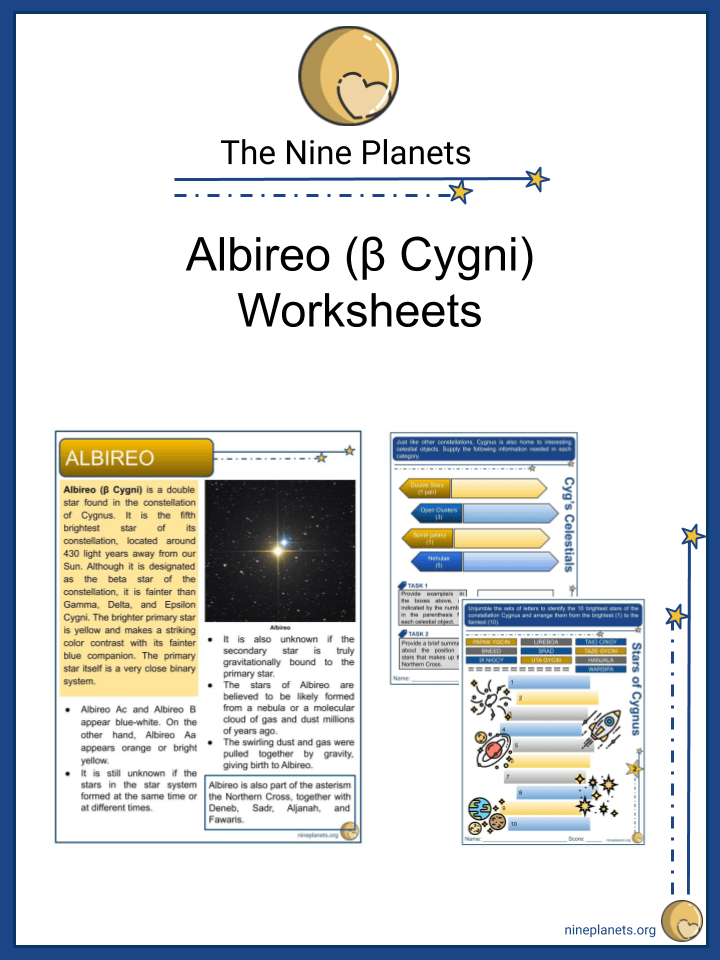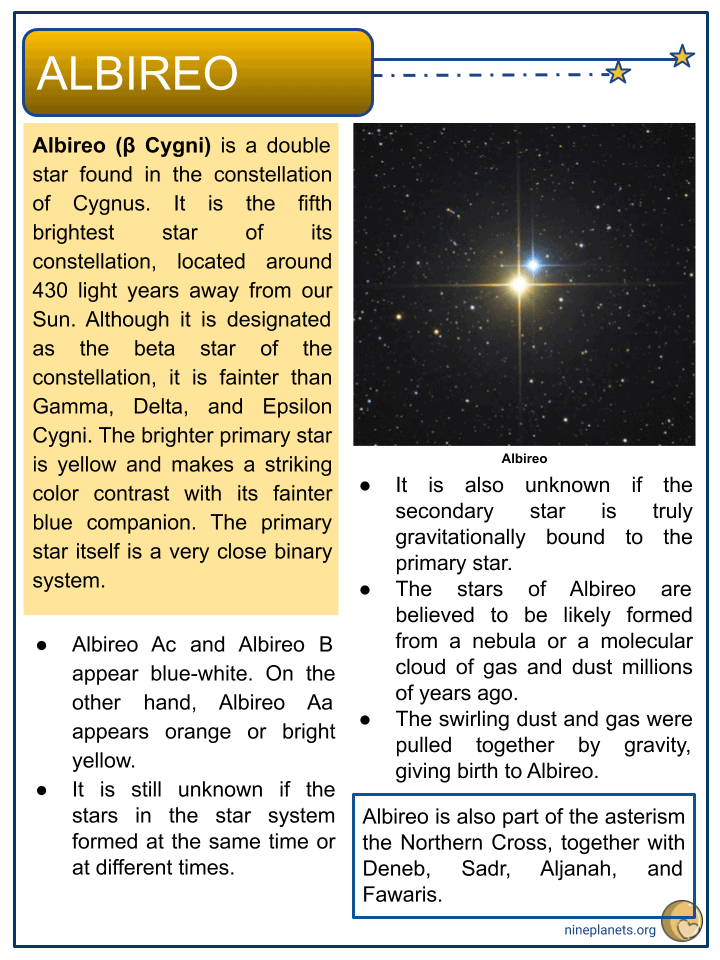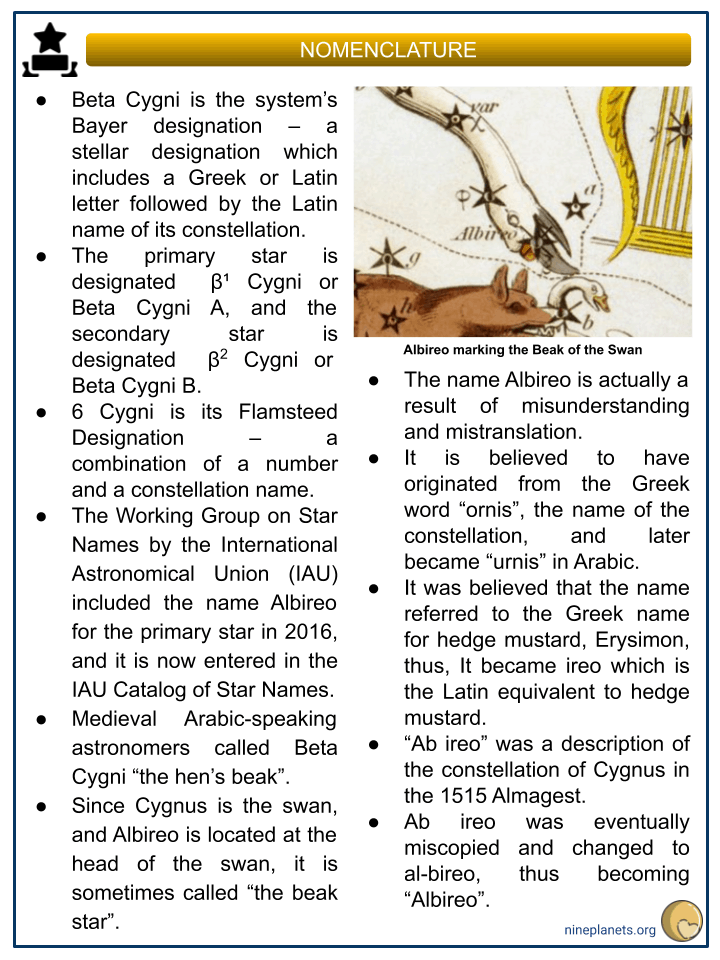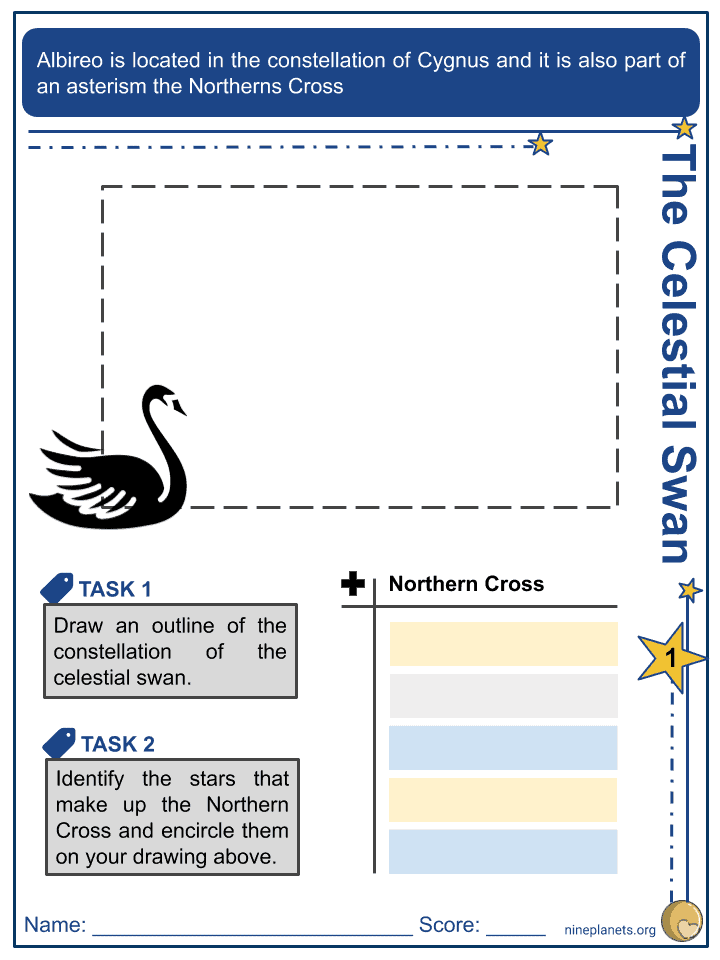Download Albireo (β Cygni) Worksheets
Click the button below to get instant access to these premium worksheets for use in the classroom or at a home.

This worksheet can be edited by Premium members using the free Google Slides online software. Click the Edit button above to get started.
Download free sample
Not ready to purchase a subscription yet? Click here to download a FREE sample of this worksheet pack.
Resource Examples
Click any of the example images below to view a larger version.
Key Facts & Information
- Albireo (β Cygni) is a double star found in the constellation of Cygnus. It is the fifth brightest star of its constellation, located around 430 light years away from our Sun. Although it is designated as the beta star of the constellation, it is fainter than Gamma, Delta, and Epsilon Cygni. The brighter primary star is yellow and makes a striking color contrast with its fainter blue companion. The primary star itself is a very close binary system.
- Albireo Ac and Albireo B appear blue-white. On the other hand, Albireo Aa appears orange or bright yellow.
- It is still unknown if the stars in the star system formed at the same time or at different times.
- It is also unknown if the secondary star is truly gravitationally bound to the primary star.
- The stars of Albireo are believed to be likely formed from a nebula or a molecular cloud of gas and dust millions of years ago.
- The swirling dust and gas were pulled together by gravity, giving birth to Albireo.
- Albireo is also part of the asterism the Northern Cross, together with Deneb, Sadr, Aljanah, and Fawaris.
Nomenclature
- Beta Cygni is the system’s Bayer designation – a stellar designation which includes a Greek or Latin letter followed by the Latin name of its constellation.
- The primary star is designated β¹ Cygni or Beta Cygni A, and the secondary star is designated β2 Cygni or Beta Cygni B.
- 6 Cygni is its Flamsteed Designation – a combination of a number and a constellation name.
- The Working Group on Star Names by the International Astronomical Union (IAU) included the name Albireo for the primary star in 2016, and it is now entered in the IAU Catalog of Star Names.
- Medieval Arabic-speaking astronomers called Beta Cygni “the hen’s beak”.
- Since Cygnus is the swan, and Albireo is located at the head of the swan, it is sometimes called “the beak star”.
- The name Albireo is actually a result of misunderstanding and mistranslation.
- It is believed to have originated from the Greek word “ornis”, the name of the constellation, and later became “urnis” in Arabic.
- It was believed that the name referred to the Greek name for hedge mustard, Erysimon, thus, It became ireo which is the Latin equivalent to hedge mustard.
- “Ab ireo” was a description of the constellation of Cygnus in the 1515 Almagest.
- Ab ireo was eventually miscopied and changed to al-bireo, thus becoming “Albireo”.
Observational History
- In the late 19th century, the primary star was photographed with the Draper Telescope as part of the Henry Draper Memorial project and its spectrum was discovered to be composite.
- Observations between 1898 and 1918 confirmed that it was a double star as variations in its radial velocity were shown.
- In 1923, the two components were listed in the Henry Draper catalog as HD 183912 and HD 183913.
- In 1978, a companion was resolved at a separation of 0.125” using a speckle interferometry at the Haute-Provence Observatory in southeast France.
- Washington Double Star Catalog (WDS) designated the companion as Beta Cygni Ab.
- In 1982, published observations revealed a companion at an angular separation of 0.44”.
- WDS designated it as Beta Cygni Ac.
Stellar System
- Albireo is located around 415 light years away from our Sun and is one of the closest beautiful and striking contrasted star system to us.
- The star can be seen with the naked eye as a single star, however, when viewed from a telescope, the secondary star, Beta Cygni B, is visible.
- The star system, Albireo A, has a radial velocity of -24 km/s and a parallax of around 7.51 arcminutes.
- Albireo A is a suspected triple star system consisting of Albireo Aa, Albireo Ab, and Albireo Ac.
- Albireo Ab is much closer to Albireo Aa, it was 0.1” away when it was discovered and now it is 0.0” away, making it impossible to resolve the pair.
- Albireo Ac is separated from Albireo Aa by around 0.4 arcseconds and it would take 100 years for them to complete one orbit, thus, Albireo A orbit each other once every century.
- ALBIREO Aa
- The primary star, Beta Cygni Aa, is of spectral type K2II.
- It has a mass of around 14.52 solar masses and a radius of around 69 solar radii.
- Beta Cygni Aa has two companion stars aside from Beta Cygni B.
- It has an apparent magnitude of 3.18 and an absolute magnitude of -2.45.
- The primary star has an average surface temperature of 4,270 K, cooler than our sun, but it is around 1.2 times bigger than the sun and has around 1,200 solar luminosities.
- Albireo Aa has an average surface gravity of around 2 cgs.
- It is a slow spinner with a rotational velocity of around 1.4 km/s.
- ALBIREO Ac
- One of the companions of the primary star, Beta Cygni Ac, is of spectral type B8:p.
- It has a mass of around 3.84 solar masses and its radius is currently unknown.
- Albireo Ac has an apparent magnitude of 5.82 and an absolute magnitude of -25.
- It is 3.84 times more massive than our sun.
- The third star has a luminosity of 950 solar luminosities and an average surface temperature of around 30,000 K.
- Other information about Beta Cygni Ac is still unknown.
- ALBIREO B
- The secondary star, Beta Cygni B, is of spectral type B8Ve.
- It has a mass of around 3.7 solar masses and a radius of around 2.59 solar radii.
- Beta Cygni B has an apparent magnitude of 5.11 and an estimated surface gravity of around 4 cgs.
- The secondary star has an average surface temperature or 13,200 K and a luminosity of around 230 solar luminosities.
- Albireo B is a fast spinner with an estimated rotational velocity of 250 km/s and a radial velocity of around -18.80 km/s.
- Its rotational velocity caused it to lose its mass very fast and it is surrounded by a circumstellar disk of gas.
- It has an estimated parallax of 18.16 arcminutes.
- Beta Cygni Aa and B are separated by around 34.4 arcseconds and it is still unknown if they are gravitationally bound to each other as they do not share a common proper motion across the sky.
- If they are a binary system, it would take around 75,000 years for the primary and secondary stars to complete one orbit.
- The Washington Double Star Catalog lists 10 more faint companions with magnitude not brighter than 10.
- Albireo B is the only close companion and the others vary in distance from the primary star, with the furthest being 142 arcseconds away.
- Due to the massiveness of Beta Cygni Aa, it is considered a candidate supernova.
- It is difficult to predict when will the star enter the supernova stage.
- Studies suggest that around the year 3,870,000, the star will be the brightest in the night sky and will come within 80 light years of the solar system.
- Around the year 4,610,000, it will shine at magnitude 0.52, a little fainter than Canopus which is the second brightest star in the night sky.
Location
- Albireo is located in the constellation of the celestial Swan, Cygnus, and it marks the beak of the swan.
- The constellation of Cygnus is 16th largest in the night sky with an area of 804 square degrees.
- It is one of the Greek constellations that appeared in 2nd Century Almagest by Greco-Roman Ptolemy.
- Cygnus is also home to interesting celestial objects such as the double stars Fawaris and Mu Cygni, the open clusters M29, M39, and NGC 6910, the spiral galaxy NGC 6946 or the Fireworks Galaxy, the nebulae North America Nebula, Pelican Nebula, Crescent Nebula, Gamma Cygni Nebula, Veil Nebula, and the Blinking Planetary Nebula.
- The stars and deep sky objects of Cygnus are best seen during the month of September for observers in the Southern Hemisphere, and in the months of June to December for observers in the Northern Hemisphere.
- Albireo is also part of the asterism the Northern Cross and marks the pole together with Deneb and Sadr. Deneb also marks the top of the cross, while Aljanah and Fawaris form the crossbeam.
- The 10 brightest stars of the celestial swan are: Deneb (Alpha Cygni), Sadr (Gamma Cygni), Aljanah, (Epsilon Cygni), Fawaris (Delta Cygni), Albireo (Beta Cygni), Zeta Cygni, Xi Cygni, Tau Cygni, Iota Cygni, and Kappa Cygni.
Greek Mythology
- Cygnus is associated with several Greek mythologies. Among these, the myth of Phaeton is one most frequently associated with the constellation of Cygnus.
- Cycnus and Phaeton were racing each other across the sky when their chariots burned up as they came too close to the Sun and fell into the Earth.
- Cycnus looked for his colleague and discovered the dead body of Phaeton trapped at the bottom of the Eridanus river.
- He made a pact with Zeus to recover the body, and agreed that if the god gave him the body of a swan, he would only live the lifespan of the swan.
- Zeus agreed and transformed him into a swan.
- Cycnus dived into the river to retrieve the dead body of Phaeton and gave him a proper burial.
- Due to this, the soul of Phaeton was allowed to travel to the afterlife.
- Zeus was moved the by sacrifice of Cycnus and placed his image sky as the constellation of Cygnus, the celestial swan.



